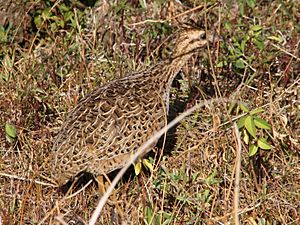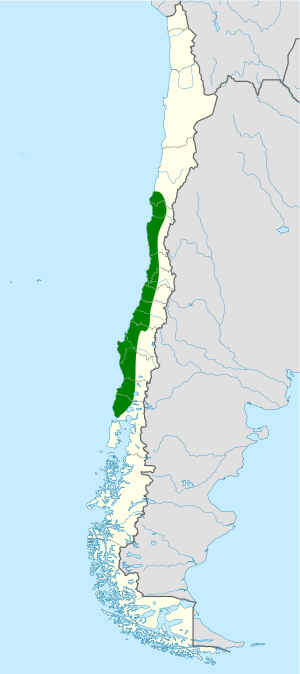Chilean tinamou facts for kids
Quick facts for kids Chilean tinamou |
|
|---|---|
 |
|
| Conservation status | |
| Scientific classification | |
| Genus: |
Nothoprocta
|
| Species: |
perdicaria
|
| Subspecies | |
|
N. p. perdicaria (Kittlitz, 1830) |
|
 |
|
| Synonyms | |
|
|
The Chilean tinamou (Nothoprocta perdicaria) is a special type of bird. It is often found in high, bushy areas in the middle part of Chile. These birds are known for being a bit shy and hard to spot.
Contents
About the Chilean Tinamou
All tinamous belong to the bird family called Tinamidae. They are also part of a larger group of birds known as ratites. You might know other ratites like ostriches or emus. Unlike most ratites, tinamous can actually fly, though they are not very strong flyers. Scientists believe that all ratites came from ancient flying birds. Tinamous are the closest living relatives to these old flying birds.
The scientific name for the tinamou, Crypturellus, comes from three old words. Kruptos means 'covered' or 'hidden'. Oura means 'tail'. And ellus means 'small'. So, Crypturellus means 'small hidden tail', which describes how their tails look!
Different Kinds of Chilean Tinamou
There are two main types, or subspecies, of the Chilean tinamou:
- N. p. perdicaria: This type lives in the dry, grassy areas of north-central Chile. You can find them in regions like Atacama, Coquimbo, Valparaíso, Santiago, O'Higgins, Maule, and Ñuble.
- N. p. sanborni: This type lives in south-central Chile. They are found in the Maule, Ñuble, Bio-bio, and Araucanía Regions. They also live in the northern part of the Los Lagos Region and nearby areas of Argentina.
Where They Live
The Chilean tinamou likes to live in high, bushy areas. These places are usually between 400 and 2,000 meters (about 1,300 to 6,500 feet) above sea level. This bird lives all over Chile, except for the very southern parts and some northern regions.
They can also be found in dry mountain forests. Here, they live among trees like Acacia caven, Porlieria chilensis, and the rare Jubaea chilensis (Chilean palm tree). Some Chilean tinamous have also been brought to Easter Island.
What They Look Like
The Chilean tinamou is about 29 centimeters (11 inches) long. It has a stocky body and a very short tail. Its beak is curved, similar to a California quail. This bird has thick, short, pale yellowish legs. It usually walks upright.
Its upper body has a complex striped pattern. Its face is a light yellowish-brown with a dark line near its eye. It also has a small stripe on its cheek and a lighter colored head. Its neck is brown with dark spots on the lower part. The sides of its chest have a streaky, grey pattern.
If you see a Chilean tinamou just south of the Maule Region, its chest might be brownish instead of grey. It also might have more reddish-brown stripes on its upper body and bottom. When on the ground, its large wings cover its body. When it flies, its wings look big and reddish-brown underneath. The wings are also rounded.
Their Sounds
The Chilean tinamou makes a loud, clear whistle. It sounds like "sweee weee" and has two parts. If the bird is feeling stressed, it makes a series of lower whistles. This sounds like "swee wee wee wee" and comes with quick wing sounds.
How They Behave
Female Chilean tinamous lay about 10 to 12 shiny eggs in a simple nest on the ground. The male bird then sits on the eggs to keep them warm. He also raises the young chicks. If the male leaves the nest, he covers the eggs with feathers to hide them.
The eggs hatch in about 21 days. The chicks are light yellowish-brown with dark stripes. They can run very soon after they hatch. They can even fly when they are only half-grown! As they get older, some blue or grey spots might appear on them.
Looking After Them
The IUCN (International Union for Conservation of Nature) says the Chilean tinamou is a species of "Least Concern". This means they are not currently in danger of disappearing. They live in a large area, covering about 120,000 square kilometers (about 46,000 square miles).
See also
 In Spanish: Perdiz chilena para niños
In Spanish: Perdiz chilena para niños


